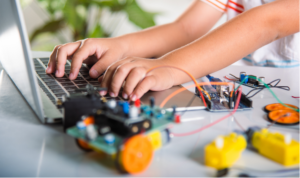What Is STEAM Education?
STEAM stands for science, technology, engineering, arts, and mathematics. Unlike traditional STEM (science, technology, engineering, and mathematics) education, which focuses solely on scientific concepts, STEAM integrates the arts and humanities. It’s a holistic, interdisciplinary approach to learning that fosters creative problem-solving, collaboration, and critical thinking1.
The Components of STEAM:
- Science: Understanding natural phenomena, conducting experiments, and exploring the world around us.
- Technology: Using tools, software, and digital resources to solve problems.
- Engineering: Designing and building solutions, considering constraints and optimization.
- Arts: Engaging in creative expression, whether through visual arts, music, drama, or dance.
- Mathematics: Applying mathematical concepts to analyze and solve real-world problems.
Benefits of STEAM Education:
- Developing Soft Skills: STEAM education goes beyond academic knowledge. It nurtures creativity, critical thinking, collaboration, and communication skills. These soft skills are essential for success in the 21st-century workforce2.
- Increased Engagement and Motivation: When students work on projects that integrate multiple disciplines, they become more engaged. The hands-on, practical nature of STEAM activities keeps them motivated to learn.
- Personalized Learning Experience: STEAM allows students to explore their interests and strengths. They can choose projects that resonate with them, leading to a more personalized learning journey.
- Technology Literacy: In an increasingly digital world, technology literacy is crucial. STEAM education equips students with the skills needed to navigate and create using technology2.
- Critical Thinking: STEAM projects encourage students to analyze problems from different angles, consider multiple solutions, and make informed decisions.
- Collaboration: Working in interdisciplinary teams teaches students how to collaborate effectively. They learn to appreciate diverse perspectives and contribute to collective success.
- Cultural Competence: By integrating arts and humanities, STEAM promotes cultural awareness and understanding. Students learn to appreciate different viewpoints and traditions.
- Preparation for the Future: As we face complex global challenges, STEAM prepares students to tackle real-world problems. Whether it’s sustainable energy, healthcare, or climate change, innovative solutions require a STEAM mindset3.
STEAM education isn’t just about learning facts; it’s about fostering innovation, creativity, and a deep understanding of the interconnected world we live in. So, whether you’re catching Pokémon or racing Mario Kart robots, STEAM is the key to unlocking your potential! 🚀🌟14


